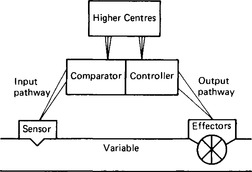Mechanisms of control
Publisher Summary
This chapter reviews the physiological concepts related to various control mechanisms. The fundamental concept in physiology is that of control. This includes control of the internal environment so as to permit cell and organ function to continue at an optimal level, and control in the sense of the direction of both conscious and unconscious functions on which, however indirectly, the survival of the individual and the species depends. Most control systems are termed feedback systems, because information about any changes that are occurring must be fed back to some controller that can cause an appropriate action, usually one to restore the original condition. Systems of this kind are negative feedback systems—the active change reversing the initial change. Negative feedback systems are inherently stable, always resisting change. They are typical of biological systems. The control of a central heating system provides an everyday example of a negative feedback system. Heaters are set to maintain a given temperature in a room. Any departure from the set temperature causes the heaters to operate more actively if temperature falls, or less actively if temperature rises. Positive feedback systems, with their natural instability, are much less common. The chapter describes reflex as as an involuntary response to a peripheral stimulus. Reflexes like coughing, sneezing, vomiting, and swallowing have centers in the medulla. Reflexes involving visual stimuli pass through the midbrain. Studies on men with spinal or brain injuries have demonstrated different levels of reflex control.
Feedback and control systems
The fundamental concept in physiology is that of control. This includes control of the internal environment so as to permit cell and organ function to continue at an optimal level, and control in the sense of the direction of both conscious and unconscious functions on which, however indirectly, the survival of the individual and the species depends. Control of the internal environment means the maintenance of an environment for the cells of the body, stable in temperature, in osmotic activity, in pH and in the concentrations of ions, nutriments and metabolites. The term homeostasis is used to describe this maintenance of a stable environment. In this chapter the essential elements of a control system will be considered; this outline will form a framework for the consideration of homeostatic mechanisms and other control systems in subsequent chapters.
A basic control system
The basic elements of a control system are summarised in a block diagram (Fig. 13.1). The variable factor to be controlled must be measured by some sensor – in biological terms, a receptor. Some receptors monitor the variable directly, others indirectly. Thus the carotid body chemoreceptors assess directly the partial pressure of oxygen dissolved in the blood. The chemoreceptors of the medulla oblongata measure blood carbon dioxide, but they do this by measuring the hydrogen ion concentration in the cerebrospinal fluid, a related variable.
The information must be fed back to some controlling centre along an input pathway, usually a nerve, although in some instances this is not necessary because the sensor and the controlling centre are the same cell.
The effector organ is usually muscle or a gland, capable of changing the controlled variable.
Stay updated, free dental videos. Join our Telegram channel

VIDEdental - Online dental courses



